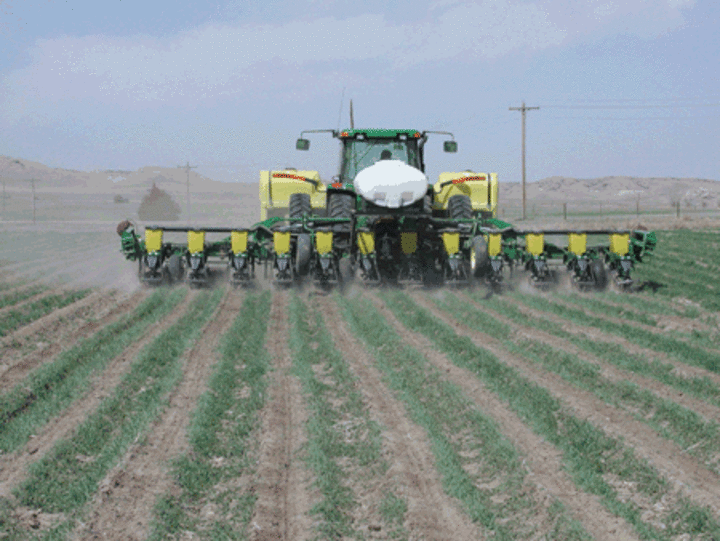March 20, 2009
This is one in a series of publications on Meeting the Challenge: Farming in Uncertain Times, written by specialists at the Panhandle Research and Extension Center. For more go to http://www.panhandle.unl.edu/meeting_challenge.htm
This is one in a series of publications on Meeting the Challenge: Farming in Uncertain Times, written by specialists at the Panhandle Research and Extension Center. For more go to http://www.panhandle.unl.edu/meeting_challenge.htm
Farmers who want to reduce high input costs face a decision at planting time: How many seeds per acre to put in the soil? Planting fewer seeds per acre saves money up front, but how does plant population affect yield?

|
| A western Nebraska grower plants sugarbeet into a winter wheat cover crop. Planting at the optimum population for your field and conditions can help assure maximum yields without overspending for seed. (File photo) |
The optimum density or plant population for any given situation results in mature plants that are sufficiently crowded to efficiently use resources such as water, nutrients, and sunlight, yet not so crowded that some plants die or are unproductive. At this population, production from the entire field is optimized, although any individual plant might produce less than would have occurred with unlimited space.
Many factors influence the optimum plant population for a crop: availability of water, nutrients and sunlight; length of growing season; potential plant size; and the plant's capacity to change its form in response to varying environmental conditions (morphological plasticity). One example of this is tillering, which allows small grain crops like winter wheat to produce the same number of heads and final grain yield in a given area over a wide range of plant densities. Modern corn cultivars, on the other hand, have been selected to produce few if any tillers. Consequently, corn has a relatively narrow range for optimum plant population.
Corn. For corn, optimum plant population can be influenced by hybrid maturity. Research in the Corn Belt by Pioneer Hi-Bred International found that harvest populations for early maturing hybrids (less than 100 days to crop relative maturity, or CRM) are optimized at populations above 30,000 plants per acre. For hybrids with maturities between 100 and 113 CRM, the optimum plant population was 28,000 plants per acre. For late maturing varieties (more than 113 CRM) the optimum plant population was 26,000 plants per acre. They found the risk of not achieving full grain yield potential was greatest when final stands were below 26,000 plants per acre.
Remember that to achieve a given harvest population, seeding rates need to be greater than the harvest population to account for seed germination rates of less than 100 percent and less-than-ideal seed bed conditions.
Optimum populations for dryland corn are derived from research conducted in the Panhandle in 1999 and 2000, supplemented with computer crop simulation modeling. Using 48 years of historical climate data, computer crop simulations suggested that, although corn yields could be increased with increased plant population density in years with above-normal precipitation, there were not enough wet years to justify plant populations above 12,000 plants per acre.
Dry Bean. Optimum established plant populations in dry beans depend on market class, plant type and productivity, and individual producer experience with particular fields and varieties. Indeterminate semi-vine (Type III) pinto and Great Northern varieties usually perform best at 60,000 to 80,000 established plants per acre. Higher plant populations (75,000 to 90,000 plants per acre) are preferred for determinate bush (Type I) and indeterminate upright (Type II) varieties because they have a more compact growth habit; that is, they have less morphological plasticity.
|
More information |
Light red kidney and black bean varieties that possess Type I and Type II growth habits are often planted to achieve an established plant population of 85,000 to 100,000 plants per acre. Generally, higher plant populations are suggested for lighter, less productive soils than for heavier, more productive soils. Yield potential will generally decrease with established plant populations below 40,000 to 50,000 plants per acre under full irrigation. Dryland bean producers typically target plant populations between 20,000 and 40,000 plants per acre.
Sugarbeet. Optimum plant populations for maximum sugar yields in irrigated sugarbeets fall between 30,000 and 40,000 plants per acre. Achieving a high plant population becomes more difficult as row widths increase, because in-row spacing between sugarbeet plants becomes quite small in wider rows.
Sunflower. Sunflowers can compensate somewhat for differences in plant population through adjustments in head size. Higher populations are generally planted for oil type than for confection type hybrids. Plant populations for oilseed hybrids range from 14,000 to 22,000 plants per acre. The lower populations are used under dryland conditions when soil-water levels at planting are low and the higher populations are used under irrigation. The plant population range for confection-type sunflower hybrids ranges from 12,000 to 18,000 plants per acre.
Reducing Seeding Rates
Growers who want to reduce seed cost by planting at lower plant populations should be careful not to get too low for their particular crop or conditions. Crops or crop varieties with the capacity to change form in response to varying environmental conditions, for example winter wheat or dry beans with a Type III growth habit, are likely to be least affected by a reduction in plant population.
Drew Lyon
Extension Dryland Crops Specialist, Panhandle REC
